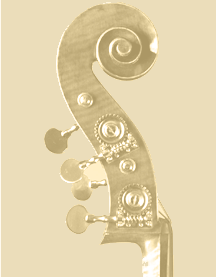Viennese Tuning
Today's upright bass was not always tuned E,A,D,G as it is now.
Still even now, there are some players that have different tunings.
Some, (a few) tune their basses like a cello, with a low C, G, D and
high A., but this is rare. Others, especially in European
orchestras will play on 5 string basses with a low B string. More than 200 years ago
though, there was a
bevy of bass concertos written for the bass using the tuning, FADF#A.
So many of these concertos were written in D or Eb Major.
Vienna was a huge musical center. The basses then were
tuned FADF#A and with 5 strings. While one normally assumes that
with many years of playing and instrument evolution of basses it is
"better" today, in fact, these wonderful concertos written then were
actually much easier to play on their original Vienna tuning than on
our present way of tuning. The official name or the type of bass
played then (in Vienna) was actually a Violone. (Vee-alone-y).
For those now familiar with traditional bass concertos by
Dittersdorf, Vanhal or Sperger, playing them on basses tuned in
fourths sometimes require adaptations to make them easier to play on
today's basses, though one might think that it would be easier
today. While the integral music (melodies) are
retained, the original performance practices such as "easy" double stops can
become pretty akward using today's common tunings. Another distinct characteristic often
noticed by the Viennese tuned basses is that they tend to sound
vibrant, 'open' and more resonant than the typical steel, 4 string
basses.
Johann Matthias Sperger lived from 1750-1812.
He was not only a 'bass' virtuoso, he was also a prolific composer
who wrote as many as 18 bass concertos (with orchestral
accompaniment), solo sonatas as well has duos and trios. Again,
while there are mainly only a few of his works actually performed
today, one major reason that there are not many editions to play
today lends itself again to the tuning cross over which actually
made them too hard to play or ruined the flow that the original
tuning achieved.
Why are some concertos (like Dittersdorf) written in Eb??
It is because the orchestra woodwind instruments were geared and
made to play in Eb. The basses were simply tuned up
1/2 step, 'solo' tuning. For those not completely familiar with solo tuning ideas...while
the soloist played in D major on his bass, the actual sounding pitch
was tuned to Eb. Tuning this way not only solved the most
obvious writing and arranging problems with the rest of the
orchestra then, it also gave the bass a kind of 'cello like'
response and timbre that would make the instrument stand out more.
Even today, most bass recitals tend to be played with basses
played in solo tuning. For the most part, solo
tuning today consists of F#BEA. Solos strings today are
slightly thinner (not usually too noticeable) but need to be a
slightly thinner diameter and gauge so that the bass can tolerate
the raised and higher tension that is added this way.
Orchestra strings tuned up (as solo tuning) will not only be very
tight to play on, but can actually damage the top of the instrument.
Today, some players will actually specialize or perform music using
the historic Viennese tuning.
In the present age, most all orchestra bass players use metal
strings on their basses and the strings are far lower to the
fingerboard than they were 200 years ago. Because of the much
higher tensions achieved with the metal strings, they are loud,
responsive and do not require as much vibration distance
(oscillating string room) as the old, 'looser' set ups needed.
Before reading about the history of bass tuning, I often wondered
how any bass players in Mozart's day could ever manage something so
difficult as his Symphony #35 (fourth movement) using their gut
strings and played with a fast tempo. Only now do we realize
that it might not have been such an incredibly impossible feat when
using their Viennese tunings. In some respects, the passages
could have been playable. On the other hand, Mozart's Symphony
#35 is hard no matter when you were (are) alive!
More about the history and different tunings. If you would
like to get into more about the historical evolution of the bass,
it's body, tuning, construction and well, just everything about
them, check out "A New History of the Double Bass" by Paul Brun. It is an incredibly interesting book and for anyone
serious about the bass, it is a great reference tool packed with
information.
|


